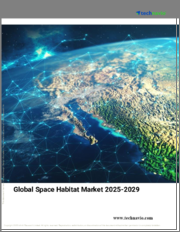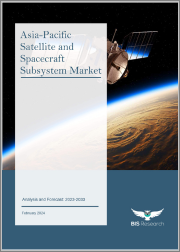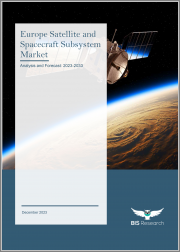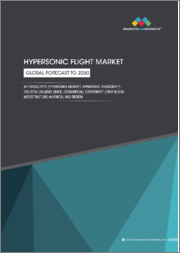
|
시장보고서
상품코드
1716736
인도의 우주 서비스 시장 : 서비스별, 용도별, 지역별, 기회 및 예측(2019-2033년)India Space Service Market Assessment, By Service, By Application, Region, Opportunities and Forecast, FY2019-FY2033F |
||||||
인도의 우주 서비스 시장 규모는 2026-2033년의 예측 기간 동안 15.22%의 연평균 복합 성장률(CAGR)로 확대되어 2025년 23억 8,000만 달러에서 2033년 73억 8,000만 달러로 성장할 것으로 예측됩니다. 인도의 우주 서비스 시장은 민간 부문의 진입을 촉진하는 혁신적인 정책과 기술 발전에 힘입어 큰 변화를 겪고 있습니다. 정부 기관은 민관 협력 환경을 구축하여 인도를 세계 무대에서 경쟁국으로 자리매김하고 있습니다. 이러한 전략적 전환은 위성 배치와 우주 이용 서비스 역량 강화에 중점을 두어 활기찬 우주 경제로 가는 길을 열고 있습니다. 지역적으로는 인도 남부의 카르나타카 주와 타밀 나두 주가 도약의 거점이 되고 있습니다. 이 지역에는 인도우주연구기구와 같은 벵갈루루의 최고 기관들이 지원하는 항공우주 및 방위산업체들의 활발한 생태계가 있습니다. 이러한 전문 지식과 자원의 집중은 많은 혁신을 촉진하여 혁신적인 우주 기술 개발 속도를 가속화할 수 있습니다. 발사체를 제조하고 제공하는 민간 기업의 출현은 경쟁력 있고 저렴한 위성 발사 서비스의 성장세를 보여주고 있습니다. 이는 위성 배치로 인한 막대한 우주 수요를 충족시킬 뿐만 아니라 인도의 역량을 확대할 수 있습니다. 민간 기업 시장 진입을 통해 각 기업은 보다 효율적으로 사업을 전개하고 비용을 절감할 수 있으며, 인도가 우주 분야에서 세계적인 존재로 자리매김할 수 있게 될 것입니다.
예를 들어, 2024년 10월 인도우주연구기구(ISRO)는 우주 관광을 위해 특별히 설계된 최첨단 재사용 가능한 로켓과 캡슐 시스템을 도입했습니다. 이 혁신적인 시스템은 승객을 100km 고도까지 운반하고 총 비행 시간 약 8.5 분 동안 약 3.5 분 동안 무중력 상태를 제공하도록 설계되었습니다. 이번 개발은 인도의 상업적 우주 역량을 강화하고 우주 관광을 경제적으로 이용할 수 있도록 하겠다는 ISRO의 전략적 비전에 부합합니다. 또한 ISRO는 위성 발사, 유인 우주 비행, 2035년까지 계획된 인도 우주정거장 지원, 2040년까지 계획된 유인 달 탐사 등 다양한 임무를 위한 3단식 부분 재사용 가능한 중량물 운반선인 차세대 로켓(NGLV)을 개발하고 있습니다. 진행하고 있습니다.
인도의 우주 서비스 시장에 대해 조사했으며, 시장 개요와 함께 서비스별/용도별/지역별 동향, 시장 진출 기업 프로파일 등의 정보를 전해드립니다.
목차
제1장 프로젝트의 범위와 정의
제2장 조사 방법
제3장 미국 관세의 영향
제4장 주요 요약
제5장 고객 소리
제6장 인도의 우주 서비스 시장 전망, 2019년-2033년
- 시장 규모 분석과 예측
- 시장 점유율 분석과 예측
- 서비스별
- 발사 로켓 서비스
- 위성 제조
- 지상 서비스
- 데이터 서비스
- 컨설팅 및 지원 서비스
- 기타
- 용도별
- 지구관측 및 원격탐사
- 통신 서비스
- 내비게이션 및 포지셔닝
- 우주 조사
- 방위 및 안보
- 지역별
- 북부
- 남부
- 동부
- 서부/중앙부
- 기업별 시장 점유율 분석(주요 5개사 및 기타 - 금액 기준, 2025년)
- 서비스별
- 2025년 시장 맵 분석
제7장 밸류체인 분석
제8장 Porter의 Five Forces 분석
제9장 PESTLE 분석
제10장 시장 역학
- 시장 성장 촉진요인
- 시장이 해결해야 할 과제
제11장 시장 동향과 발전
제12장 사례 연구
제13장 경쟁 구도
- 시장 리더 주요 5개사의 경쟁 매트릭스
- 참여 기업 주요 5개사의 SWOT 분석
- 시장 주요 기업 주요 10개사의 상황
- Digantara Research and Technologies Private Limited
- Skyroot Aerospace Private Limited
- Agnikul Cosmos Private Limited
- Bellatrix Aerospace Pvt. Ltd
- Dhruva Space Private Limited
- Pixxel Space Technologies, Inc
- Ananth Technologies PVT. LTD.
- Data Pattern(India) Ltd.
- Larsen & Toubro Limited
- Antrix Corporation Limited
제14장 전략적 제안
제15장 회사 소개 및 면책조항
LSH 25.05.19India space service market is projected to witness a CAGR of 15.22% during the forecast period FY2026-FY2033, growing from USD 2.38 billion in FY2025 to USD 7.38 billion in FY2033. The space service market in India is witnessing a significant transformation, driven by innovative policies and technological advancements that encourage private sector participation. The government agencies have created a collaborative environment between public and private entities, positioning India as a competitive player on the global stage. This strategic shift focuses on enhancing capabilities in satellite deployment and space-enabled services, paving the way for a vibrant space economy. Regionally, Karnataka and Tamil Nadu in Southern India are becoming a hub for exponential growth. The region has a vibrant ecosystem of aerospace and defense enterprises supported by top Bengaluru institutions such as the Indian Space Research Organization. The presence of such concentrations of expertise and resources can drive much innovation and thereby quicken the pace of developing innovative space technologies. The emergence of private players that build and provide launch vehicles shows growth toward competitive and affordable satellite launch services. This expands on India's capabilities besides fulfilling the vast demand in space due to satellite deployment. Thereby, with private players entering the market, each one operates more efficiently and drives down costs while further establishing India as a global entity in the space arena.
For instance, in October 2024, The Indian Space Research Organisation (ISRO) introduced a cutting-edge reusable rocket and capsule system specifically designed for space tourism missions. This innovative system is engineered to transport passengers to an altitude of 100 kilometers, providing them with approximately 3.5 minutes of weightlessness during a total flight duration of around 8.5 minutes. The development aligns with ISRO's strategic vision to enhance India's commercial space capabilities and make space tourism more economically accessible. Additionally, ISRO is progressing with its Next Generation Launch Vehicle (NGLV), a three-stage, partially reusable heavy-lift vehicle intended for diverse missions, including satellite deployment, human spaceflight, and supporting India's planned space station by 2035 and crewed lunar mission by 2040.
Navigation and Mapping Drives the Market
Improved navigation and mapping services are major drivers for India's growing space service market as demand escalates for more authentic and elaborative digital maps. The government's increase in investments in infrastructure and smart cities demands reliable mapping solutions, especially in transportation, logistics, and urban planning applications where accuracy is important. Increasing application of location-based services and the rise of more ride-hailing and delivery further drive requirements for real-time navigation solutions; further advancements also enhance GIS capacity in agriculture, environmental monitoring, and other areas; as such, it continues to provide an impetus for growth on the Indian side.
For instance, in July 2024, Dhruva Space Private Limited obtained official authorization from IN-SPACe to deliver Ground Stations as a Service (GSaaS). This service guarantees dependable data transmission, increases mission adaptability, and lowers operational expenses for ground station activities. GSaaS facilities located in equatorial regions, particularly those supporting low Earth inclination orbits, provide extended satellite visibility periods, decreased communication delays, and improved signal dependability owing to reduced atmospheric disturbances. These strategically positioned, cost-efficient stations are optimized to enhance global satellite operations across various applications, including telecommunications and remote sensing, while also offering valuable support for launch vehicle tracking activities, leveraging India's advantageous geographic position.
Satellite-based Internet Fuels the Demand
Satellite-based internet fuels the Indian space service market, and this helps bridge the digital divide in rural and underserved areas. Traditional internet infrastructure simply cannot adequately serve these regions, and that is where satellite-based connectivity comes in as a ready and scalable solution. The government's focus on digital inclusion fits well with the increasing requirement for reliable internet access to allow communities in all regions to unlock critical services like education, healthcare, and e-commerce. Partnerships among satellite operators and local telecom companies are facilitating inroads. In contrast, technical improvements in Low Earth Orbit (LEO) satellites are cutting down latency and providing faster speeds, thus better performance.
For instance, in January 2024, The Indian National Space Promotion and Authorisation Centre (IN-SPACe) is anticipated to grant necessary clearances to Reliance Jio, enabling the company to introduce satellite-based broadband services across India. Upon receiving these approvals, Reliance Jio will achieve the distinction of becoming the nation's inaugural provider of satellite internet services, marking a significant milestone in India's digital connectivity landscape and expanding broadband access to remote regions across the country.
Inclusion of Space Technology in Agriculture Bolster the Demand
Including space technology in agriculture is significantly improving the demand for advanced agricultural practices in India. Farmers are given timely and unbiased information regarding crop conditions, soil health, and weather conditions through satellite data. This helps in monitoring activities in agriculture, which allows the farmer to make better decisions concerning irrigation, fertilization, and pest control. Initiatives such as the Forecasting Agricultural Output using Space, Agro-meteorology, and Land-based Observations (FASAL) project are excellent examples of the use of satellite imagery in augmenting crop production forecasting and resource management. Furthermore, the government is launching satellites for remote sensing capabilities to get an effective assessment of drought and mapping of land usage, which becomes critical for optimizing agricultural output.
For instance, in July 2024, Cropin Technology, an AI Platform for food and agriculture, announced the launch of Sage, a real-time agri-intelligence solution. This innovation by the company converts global agricultural terrain into specialized grid-based maps, offering customizable resolution options of 3x3 meters, 10x10 meters, or 5x5 kilometers. This sophisticated platform delivers comprehensive agricultural data and intelligence with exceptional precision, extensive coverage, and rapid processing capabilities, revolutionizing how farming data is collected and analyzed worldwide.
Launch Services Lead the India Space Service Market
The launch services segment is a leading sector of India space service market, fueled by a high demand for satellite deployments. With the rise of private companies, there is a significant focus on small satellite launches, which are very much preferred these days for their cost-effectiveness and rapid turnaround times. The Indian Space Research Organization (ISRO) has also developed new launch vehicles specific to this category, which is further increasing competition and innovation. This trend is complemented by the government's policies encouraging private sector participation and investment in space technology. Increased collaboration between public and private entities further propels advancements in launch capabilities, making India a key player in the global launch services arena.
For instance, in October 2024, Indian space startup Skyroot Aerospace publicly showcased its domestically developed Vikram-1 launch vehicle, designed to transport small satellites to low Earth orbit. The company simultaneously inaugurated its new corporate facility named 'The MAX-Q Campus' located at the GMR Aerospace and Industrial Park in Mamidipally, South Hyderabad, marking a significant expansion of its operational capabilities.
Southern India Dominates the Market
The space service market in the country is emerging to be dominated by Southern India, primarily because of the concentration of expertise and resources in states such as Karnataka and Tamil Nadu. This region houses a robust ecosystem of aerospace and defense industries, with Bengaluru being a hub for innovation, primarily driven by private players. Leading educational institutions and research centers around the region further augment the space technology development capabilities. Supportive policies and initiatives pursued by the government have also created an environment to allow the private sector to operate freely, thereby promoting the growth of startups and established companies. This collaborative landscape becomes critical for taking satellite technology and launch services to the growth trajectory, cementing the position of Southern India at the heart of Indian space ambitions.
For instance, in December 2024, the Union Ministry of Science & Technology announced financial and technical support for Chennai-based Agnikul Cosmos Private Limited to finalize development and begin commercialization of their Agnibaan launch vehicle. This versatile two-stage rocket can accommodate payloads weighing up to 300 kg for orbits at 700 km altitude, featuring several innovative advantages including: dedicated and scalable launch options for payloads ranging from 30 to 300 kg; remarkably short satellite integration timelines of just two weeks; adaptable mobile launch platforms that can operate from various global locations; and mission customization capabilities that address the limitations of conventional rideshare launch arrangements.
Future Market Scenario (FY2026-FY2033F)
The Indian space service market is poised for substantial growth, driven by government reforms and increased private sector participation, enabling innovative technologies and services.
Strengthened public-private partnerships will play a crucial role in advancing space missions, with private firms increasingly involved in satellite manufacturing and launch services.
A surge in space startups is expected to enhance India's capabilities in satellite technology and services, contributing to a more competitive landscape in the global space economy.
The upcoming expansion of satellite constellations will improve capabilities in Earth observation and data analytics, benefiting various sectors such as agriculture, infrastructure, and urban planning.
Key Players Landscape and Outlook
The competitive landscape of India's space service market is characterized by a dynamic interplay between established companies and a burgeoning private sector. The Indian Space Research Organisation (ISRO) continues to lead with its cost-effective launch capabilities and successful missions, setting high standards for reliability and innovation. Emerging private players are increasingly entering the market, focusing on developing reusable launch vehicles and advanced satellite technologies to enhance operational efficiency. The government's support through initiatives like IN-SPACe fosters collaboration between public and private sectors, creating a conducive environment for innovation. However, challenges such as reliance on imported components and the need for a skilled workforce persist, highlighting the importance of building a robust domestic supply chain to ensure sustainable growth in this competitive arena.
For instance, in May 2024, Spacetech firm Digantara Research and Technologies Private Limited, specializing in space situational awareness (SSA), was chosen to participate in the landmark Mission for Australia-India's Technology, Research, and Innovation (Maitri). This collaborative industry initiative is spearheaded by Space Machines Company and backed by substantial funding exceeding USD 5.6 million (AUD 8.5 million) from the Australian Space Agency through its International Space Investment (ISI) India Projects programme.
Table of Contents
1. Project Scope and Definitions
2. Research Methodology
3. Impact of U.S. Tariffs
4. Executive Summary
5. Voice of Customers
- 5.1. Factors Considered in Purchase Decisions
- 5.1.1. Mission Requirements and Objectives
- 5.1.2. Technical Capabilities and Expertise of Providers
- 5.1.3. Service Cost and Budget
- 5.2. Consideration of Regulations
6. India Space Service Market Outlook, FY2019-FY2033F
- 6.1. Market Size Analysis & Forecast
- 6.1.1. By Value
- 6.2. Market Share Analysis & Forecast
- 6.2.1. By Service
- 6.2.1.1. Launch Vehicle Services
- 6.2.1.2. Satellite Manufacturing
- 6.2.1.3. Ground Services
- 6.2.1.4. Data Services
- 6.2.1.5. Consulting and Support Services
- 6.2.1.6. Others
- 6.2.2. By Application
- 6.2.2.1. Earth Observation and Remote Sensing
- 6.2.2.2. Communication Services
- 6.2.2.3. Navigation and Positioning
- 6.2.2.4. Space Research
- 6.2.2.5. Defense and Security
- 6.2.3. By Region
- 6.2.3.1. North
- 6.2.3.2. South
- 6.2.3.3. East
- 6.2.3.4. West and Central
- 6.2.4. By Company Market Share Analysis (Top 5 Companies and Others - By Value, FY2025)
- 6.2.1. By Service
- 6.3. Market Map Analysis, FY2025
- 6.3.1. By Service
- 6.3.2. By Application
- 6.3.3. By Region
7. Value Chain Analysis
8. Porter's Five Forces Analysis
9. PESTLE Analysis
10. Market Dynamics
- 10.1. Market Drivers
- 10.2. Market Challenges
11. Market Trends and Developments
12. Case Studies
13. Competitive Landscape
- 13.1. Competition Matrix of Top 5 Market Leaders
- 13.2. SWOT Analysis for Top 5 Players
- 13.3. Key Players Landscape for Top 10 Market Players
- 13.3.1. Digantara Research and Technologies Private Limited
- 13.3.1.1. Company Details
- 13.3.1.2. Key Management Personnel
- 13.3.1.3. Products and Services
- 13.3.1.4. Financials (As Reported)
- 13.3.1.5. Key Market Focus and Geographical Presence
- 13.3.1.6. Recent Developments/Collaborations/Partnerships/Mergers and Acquisitions
- 13.3.2. Skyroot Aerospace Private Limited
- 13.3.3. Agnikul Cosmos Private Limited
- 13.3.4. Bellatrix Aerospace Pvt. Ltd
- 13.3.5. Dhruva Space Private Limited
- 13.3.6. Pixxel Space Technologies, Inc
- 13.3.7. Ananth Technologies PVT. LTD.
- 13.3.8. Data Pattern (India) Ltd.
- 13.3.9. Larsen & Toubro Limited
- 13.3.10. Antrix Corporation Limited
- 13.3.1. Digantara Research and Technologies Private Limited
Companies mentioned above DO NOT hold any order as per market share and can be changed as per information available during research work.



















